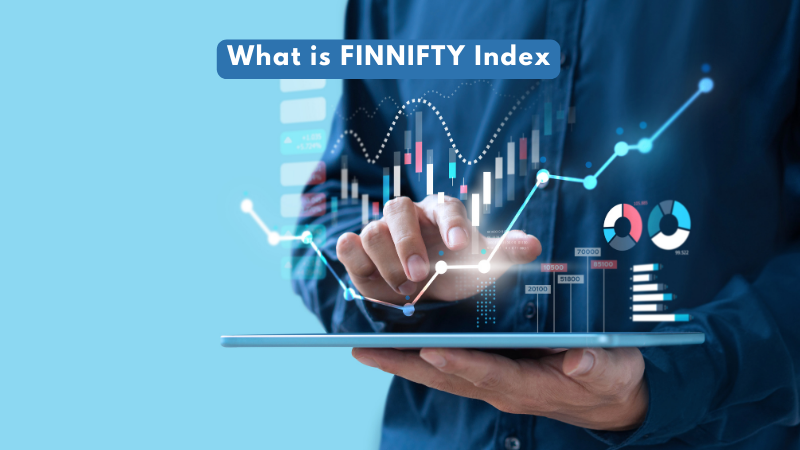
The two most popular indexes in India are NIFTY and Sensex. These are the primary indexes of NSE and BSE respectively. But did you know there are a few more indexes that are sector-specific? FINNIFTY is one such index that focuses on companies belonging to the financial sector. Know all about this index in this blog and how to invest or trade in FINNIFTY stocks.
Read More: All that you need to know about Nifty BeES
What is the meaning of the FinNIFTY index?
The Nifty Financial Services Index, popularly known as FINNIFTY, was introduced by the National Stock Exchange (NSE) on September 7, 2011. It is composed of 20 carefully selected stocks from various sectors, including banks, financial institutions, housing finance companies, insurance companies, and other financial services entities.
The main objective of FINNIFTY is to monitor and reflect the collective performance of these diverse financial companies in the market. The weight of each stock in the index is determined based on its free float capitalization value, ensuring that larger and more influential companies have a greater impact on the index’s movements.
What is the eligibility for stocks to be listed in the FINNIFTY index?
The weight of each stock will be determined by its free float capitalization in the market. The free float market capitalization is calculated using the following formula
Free Float Market Capitalisation = Outstanding shares x investable weight factors x price / IWF
Where, IWF (Investible Weight Factors) depends on the shareholding pattern reported by the company to the stock exchange.
The index has a base date of 1st January 2021 and a base value of 1000. It includes companies listed in the Nifty 500, and the index is restructured every six months. Each stock’s weight in the index is directly proportional to its free-float market capitalization, ensuring that no single stock has a weightage of more than 33%. Additionally, the combined weightage of the top three stocks during rebalancing should not exceed 62%.
Among the constituents of FINNIFTY, banks hold a weightage of 65%, while NBFCs (Non-Banking Financial Companies) have a weightage of approximately 25%, and insurance companies and other stocks collectively account for about 10%.
The three largest contributors to the Nifty Financial Services Index are HDFC Bank Ltd., ICICI Bank Limited, and Kotak Mahindra Bank Limited, together accounting for up to 62.02% of FINNIFTY’s weightage.
Which stocks come under the FINNIFTY index?
The sectors included in the FINNIFTY and their weightage is tabled below.
| Sector | Weightage |
| Banks | 63.1% |
| Housing Finance Firms | 18.5% |
| NBFCs | 8.1% |
| Insurance Firms | 8% |
| Other Financial Services | 1.3% |
| Financial Institutions | 1.1% |
Top Constituents on FINNIFTY and their weightage as of July 31st, 2023
| Company Name | Weightage |
| HDFC Bank Limited | 32.08% |
| ICICI Bank Limited | 21.53% |
| Kotak Mahindra Bank Limited | 8.41% |
| Axis Bank Limited | 8.29% |
| State Bank of India | 7.54% |
| Bajaj Finance Limited | 6.17% |
| Bajaj Finserv Limited | 2.74% |
| HDFC Life Insurance Company Limited | 2.20% |
| SBI Life Insurance Company Limited | 1.83% |
| Shriram Finance Limited | 1.60% |
How to trade or invest in FINNIFTY?
Like investing or trading in stocks on any other index, the first step for FINNIFTY stocks is also to open a Demat account. Investors can also invest in index mutual funds or ETFs that have the same stocks in the same proportion as the index. Investors can also trade in the futures and options of the stocks listed on the FINNIFTY index.
What are trading charges for FINNIFTY?
Trading charges for Finnifty depends upon the charges that have been specified by your broker. For Ex: Fisdom charges a flat rate of Rs 20 for every executed trade.
Conclusion
FINNIFTY is the index that focuses solely on the financial sector of the country and allows investors to invest in the top companies in this sector. The index has shown consistent performance with returns approximately in the range of 16% to 17%. This sector is also one of the top sectors in India and is also growing at a rapid pace and is expected to reach $150 billion by 2025 as compared to $50 billion in 2021. Therefore, investors can also get the opportunity to be part of this growth journey by investing in stocks on FINNIFTY.
FAQs
FINNIFTY derivatives are cash-settled, with the last Thursday of the month being the expiry date for monthly contracts, and Thursdays being the expiry date for weekly contracts. NSE offers options and futures in seven weekly and three monthly serial contracts. Additionally, NSE now provides weekly futures for stock derivatives, a new offering in the market.
The FINNIFTY index includes 20 stocks from the list of stocks that are already included in the NIFTY 500 index belonging to various sectors, such as banks, financial institutions, housing finance companies, insurance companies, and other financial services companies.
The FINNIFTY index is rebalanced every six months. The rebalancing ensures that the index continues to accurately reflect the performance of the 20 selected stocks in the financial services sector, based on their free float market capitalization values.
The primary requirement for stocks to be included in the FINNIFTY Index is that they must belong to the financial services sector and should already be listed on the NIFTY 500 index.


























